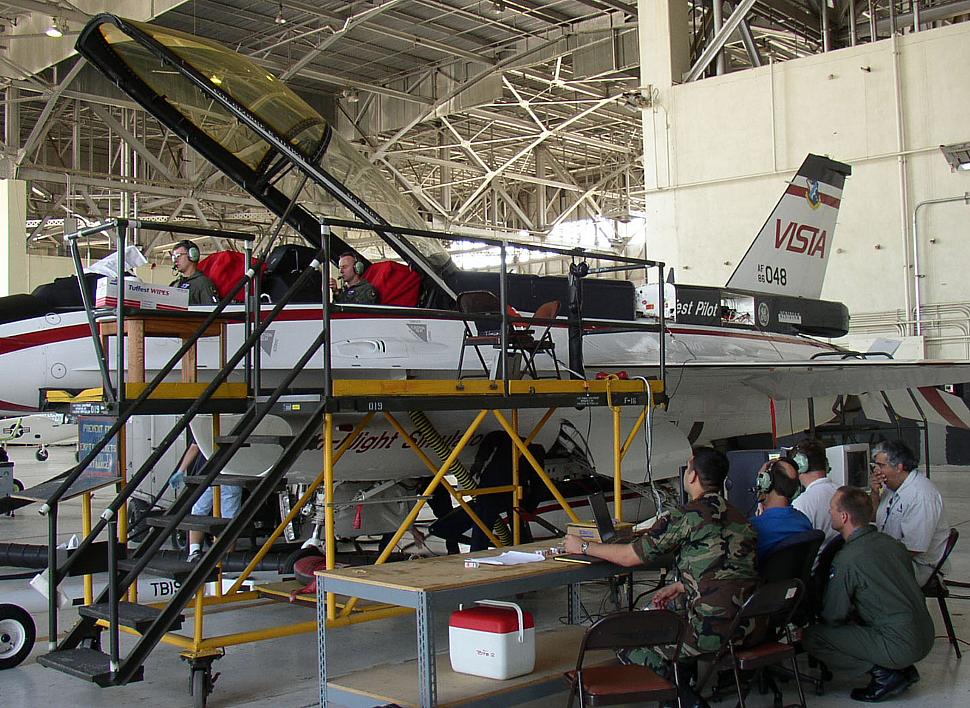Fighter Jet News
F-16 Fighting Falcon News
Auto ACAS test team receives flight safety award
October 19, 2003 (by
Lieven Dewitte) -
The Automatic Air Collision Avoidance System test team recently received the Tony LeVier Flight Test Safety Award for their exceptional contribution to flight test safety during 2003.
The team, made up of 32 core flight test members and more than nine different organizations, was presented the award in September.
The Auto ACAS is an algorithm, or computer program, which detects a potential airborne collision, chooses the optimum avoidance maneuver and sends an avoidance command to the aircraft's autopilot.
It is not designed to be a warning system. The pilot shouldn't know the system is there until it is needed to save his life.
"Although Auto ACAS is viewed as a safety system, it directly contributes to combat capability," said Maj. Jim Less, U.S. Air Force Test Pilot School Auto ACAS project pilot. "Every year we lose pilots and planes due to mid-air collisions - this system will help save both."
"Unfortunately, the future of Auto ACAS is up in the air," said Mark Skoog, NASA Dryden Auto ACAS technical advisor and flight test director. "The concept needs a backer, support to continue the system's development. The algorithm is not proprietary information, so even though it is government owned, it could benefit a variety of platforms."
Less agreed, "This is extremely important research with far-reaching application. From just a concept demonstration, we were able to prove this idea has merit. It's not ready for production, but the concept itself is groundbreaking."
The development and flight test of the Auto ACAS has been an international cooperative effort between the Air Force Research Laboratory, Sweden's FMV (F?rsvarets Materielverk), Lockheed Martin, Saab, Bihrle Applied Research, Veridian, Boeing and NASA Dryden Flight Research Center.
This international team was able to demonstrate the Auto ACAS concept in four sessions, spanning six months - March through August.
Sessions I to III, involved flights in a Lockheed Martin F-16 and the TPS Variable Stability In-Flight Simulator Test Aircraft. (VISTA - an enhanced F-16 - has the unique ability to maneuver like a variety of aircraft, demonstrating multiple flying qualities.)
The first three sessions verified procedures, software and systems on each aircraft and included collision runs against a computer-generated virtual target. These sessions were designed to collect initial data and evaluate the algorithm.
Flight testing during the final session, Session IV, evaluated collision avoidance in a series of flight scenarios using the VISTA and a production F-16 from Eglin Air Force Base, Fla.
During the scenarios, the two planes flew in a collision course, testing the system's ability to activate the autopilot avoidance maneuver and prevent a mid-air collision.
The success of Auto ACAS has opened up a plethora of research opportunities and spin-off research projects for TPS. They plan to use elements from Auto ACAS for an upcoming test program called Automated Aerial Refueling - the concept: airborne refueling for unmanned aerial vehicles...
The Auto ACAS is an algorithm, or computer program, which detects a potential airborne collision, chooses the optimum avoidance maneuver and sends an avoidance command to the aircraft's autopilot.
It is not designed to be a warning system. The pilot shouldn't know the system is there until it is needed to save his life.
"Although Auto ACAS is viewed as a safety system, it directly contributes to combat capability," said Maj. Jim Less, U.S. Air Force Test Pilot School Auto ACAS project pilot. "Every year we lose pilots and planes due to mid-air collisions - this system will help save both."
"Unfortunately, the future of Auto ACAS is up in the air," said Mark Skoog, NASA Dryden Auto ACAS technical advisor and flight test director. "The concept needs a backer, support to continue the system's development. The algorithm is not proprietary information, so even though it is government owned, it could benefit a variety of platforms."
Less agreed, "This is extremely important research with far-reaching application. From just a concept demonstration, we were able to prove this idea has merit. It's not ready for production, but the concept itself is groundbreaking."
The development and flight test of the Auto ACAS has been an international cooperative effort between the Air Force Research Laboratory, Sweden's FMV (F?rsvarets Materielverk), Lockheed Martin, Saab, Bihrle Applied Research, Veridian, Boeing and NASA Dryden Flight Research Center.
This international team was able to demonstrate the Auto ACAS concept in four sessions, spanning six months - March through August.
Sessions I to III, involved flights in a Lockheed Martin F-16 and the TPS Variable Stability In-Flight Simulator Test Aircraft. (VISTA - an enhanced F-16 - has the unique ability to maneuver like a variety of aircraft, demonstrating multiple flying qualities.)
The first three sessions verified procedures, software and systems on each aircraft and included collision runs against a computer-generated virtual target. These sessions were designed to collect initial data and evaluate the algorithm.
Flight testing during the final session, Session IV, evaluated collision avoidance in a series of flight scenarios using the VISTA and a production F-16 from Eglin Air Force Base, Fla.
During the scenarios, the two planes flew in a collision course, testing the system's ability to activate the autopilot avoidance maneuver and prevent a mid-air collision.
The success of Auto ACAS has opened up a plethora of research opportunities and spin-off research projects for TPS. They plan to use elements from Auto ACAS for an upcoming test program called Automated Aerial Refueling - the concept: airborne refueling for unmanned aerial vehicles...
Additional images:
Related articles:
Tags
- VISTA F-16 tests Automatic Air Collision Avoidance System at Edwards AFB (2003-08-14)
- Lockheed Martin F-16 tests Mid-Air Collision Prevention System (2003-07-17)
- VISTA F-16 will test airborne safety system (2003-02-11)
- F-16 Fighting Falcon news archive
Tags


